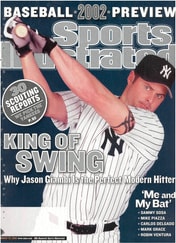
Sex Or Sport? The rebirth of the LPGA's crusade to win over fans with good looks and good cheer coincided with the death of one of its most glamorous founders--and raised an age-old question
The two blondes pictured in the old newspaper clipping are
wearing short skirts and winsome smiles. Alice Bauer, then 22,
is on her right knee, her skirt riding up the opposite thigh. In
her left hand she lightly holds a wooden club, perhaps her
driver. In another photo accompanying the story, Alice's
16-year-old sister, Marlene, is frozen in the follow-through of
her swing. The photo is taken from ground level, the camera
gazing adoringly upward at yellow curls framed against a blue
sky. It's golf. It's cheesecake. It's 1950.
Last Thursday, Marlene Bauer Hagge Vossler sat in an outdoor
cafe in Palm Desert, Calif., staring at the images of the
teenage hottie she used to be. "There's no way this hurt the
tour," she said. The New York Herald-Tribune, the paper in which
the story and the photos about the Bauer sisters appeared, went
out of business decades ago. Alice, who along with her sister
was one of the 13 founders of the LPGA, is gone now, too, having
died on March 6 of colon cancer. But Marlene remains, Marlene
and the pitch and yaw of women's golf: Sex or sport--which is
the most critical to the success of the LPGA? After 52 years the
question is still being debated. Should the tour be about
athleticism and performance, or about glamour and entertainment?
Annika Sorenstam, who lost in a playoff to Rachel Teske at last
week's Ping Banner Health Championship in Phoenix, and Karrie
Webb have developed the best rivalry in golf, yet the public
remains unmoved by it, largely because of the low wattage of
Sorenstam's and Webb's personas. At the mandatory players'
summit convened by commissioner Ty Votaw in Phoenix on March 8,
LPGA members resolved to be more approachable and to pay more
attention to their appearance. Anyone who has seen Duffy Waldorf
knows that grooming isn't important on the men's Tour, yet the
women believe they have to look good. "Does glamour help?" asks
Jill McGill, the 30-year-old who finished second in a
playboy.com poll asking which LPGA player should pose nude in
Playboy. (McGill is considering the offer to do so, winner Carin
Koch having refused.) "Glamour always helps. It's easier to get
away with being ugly as a man. This is how the real world works."
Tell Marlene about it. When she and Alice started out on the
LPGA tour, female athletes expected to be judged by their looks.
"Other than the Bauer sisters," a TIME magazine correspondent
reported in 1951, "the pros are a sexless, hippy bunch." Marlene
says that she and Alice enjoyed their reputation as glamour
girls. "I don't see why people complain about being a sex
symbol," she says. Marlene remembers the clinics that the LPGA
pros would give before tournaments, with Patty Berg as emcee.
"Patty would say, 'Look at these girls.' She would point at
Alice and me and say, 'Isn't it grand to be pretty and able to
hit it, too? With my mug, I've got to be able to hit it.'" Today
Berg, 84, says of the Bauers, "They were cute, they were fun,
and the people liked them. Everybody wanted to see Babe
[Didrikson Zaharias] and the Bauer sisters."
Marlene never resented being viewed as a pretty face. "Most
women want to be as good-looking as possible," she says. "I
wanted to play as well as I could too. It doesn't have to be one
or the other." The Bauers proved as much, Alice during her
limited career, Marlene for almost 50 years.
The Bauers' father, David, a German immigrant who settled in
Eureka, S.Dak., so fell in love with golf at age 30 that he
leased the town's nine-hole course and ran it as his own
business. He put a cut-down club in Marlene's hands when she was
three. "He tried to get Alice started, but she was about 10 and
already had other interests," Marlene says. "People would come
to the course and see me hitting balls. I was getting so much
attention that my sister decided that maybe golf wasn't such a
bad thing."
Four years later, in 1941, Alice won the South Dakota Amateur.
In the fall of '43 David loaded up the family's Model A
Ford--the car was packed so tightly that the girls had to
squeeze in up front with their father and their mother,
Madeline--and moved to Long Beach, Calif. In '47, Marlene, 13,
entered the L.A. Women's Championship, at Griffith Park, where
the scorecard read, "Children under 14 years of age are not
allowed on the course." After Marlene swept through the
tournament, she appeared in LIFE magazine practicing her putting
as her dolls watched. Two years later Marlene won the first U.S.
Girls' Junior title, at Philadelphia Country Club. While Marlene
played in that tournament, the Bauers stayed at the Philly house
of Glenna Collett Vare, the six-time U.S. Amateur champion. A
few weeks later the Amateur was held at Merion, Vare's home
course. Marlene and Alice returned and stayed with her again.
When Marlene beat Vare 4 and 3 in the second round, the upset
made headlines in The New York Times. Although Marlene was
beaten in the semis, she was named Associated Press Female
Athlete of the Year.
Alice and Marlene had homemade swings. Alice was barely 5'1" but
drove the ball as far as anyone on tour except the formidable
Didrikson. "She had the longest swing in the history of golf,"
says fellow founder Marilynn Smith. "Her backswing made John
Daly's look short." Berg says that once, after she and Didrikson
watched Alice unwind that long swing and outdrive them, Babe
turned to her and said, "Alice might be right, and we might be
wrong."
LPGA tournament manager Fred Corcoran saw to it that the Bauers
became national figures. In 1952 they appeared on Wheaties
boxes, and while the other players wore the long skirts and
pearls that had become the fashion, the Bauers stayed with their
short skirts to milk their pinup popularity. Alice and Marlene
went on a barnstorming tour of Australia in 1953 and scandalized
that nation by wearing shorts on the course. "It's simply not
done here," said an AP report from Sydney. Marlene responded,
"When you bend down to line up a putt, it's more unladylike if
you wear a skirt than if you're wearing slacks or shorts."
Alice never won an LPGA tournament and played a limited
schedule. She married and divorced three times, and after the
third divorce returned to her maiden name. Marlene, who married
twice, was a fixture on tour. She won her first tournament, in
'52, at age 18 (she remains the youngest LPGA winner ever) and
took eight titles--including the LPGA Championship--in '56. She
won for the 26th and final time in '72, although she continued
to play for 25 years.
Marlene, who will be inducted into the LPGA Hall of Fame in
November, couldn't attend the summit so soon after Alice's death.
(Alice lived her last years with Marlene and her second husband,
Ernie Vossler, in Palm Desert.) Had she attended, though, Marlene
would have told the players that they are onstage and must dress
and act accordingly. "It's show business, there's no question,"
she says. "It's like going to the theater. You pay for your
ticket and watch a performance."
Some believe that the LPGA has outgrown worrying about looks.
With purses approaching $40 million and Sorenstam and Webb
firing at pins, the tour certainly has come a long way since the
1960s, when Lenny Wirtz, then the LPGA's tournament director,
sidled up to players and told them to lose weight. The late '70s
and the '80s belonged to Nancy Lopez, who fueled the tour with
her charm, and to Jan Stephenson, who filled the sex-symbol role
once played by the Bauers. Dale Eggeling, 47, has been on tour
for 26 years, during which she has gone from glamour girl to
veteran grinder. "I was with a clothing company called Ellesse,"
Eggeling says. "They hadn't gotten around to making golf
clothes, so I wore tennis shorts. At least I had no cottage
cheese [cellulite] on my legs. When I bent down in those shorts,
I was very careful about how I picked up my ball. The older I
got, the longer my shorts became."
Stephenson turned 50 in December. Lopez, 45, said last week that
this will be her final full year on tour. As the LPGA waits for
someone with a winning smile to go along with a winning swing,
the membership has decided that all the players need to dress
better and act nicer. Says eight-year veteran Emilee Klein,
"People want to see girls who look good. Some girls don't
realize that how they look affects everybody else."
One difficulty is that most women's golfwear looks mannish. One
of the reasons why Serena and Venus Williams have delivered such
a jolt to women's tennis is because of the way they fill out
their clothes. "The Williams sisters have unbelievable bodies,"
says McGill. "Tennis has better athletes than golf, and short
skirts and tight tops don't hurt." That mentality is creeping
onto the tour. Last Friday in Phoenix, Grace Park showed a lot
of collarbone in a shirt with a rounded neck. Then there was
Catrin Nilsmark, the tour's high priestess of style, who wore
her slacks tighter than a lie on a driving-range mat. When she
stood over a putt on the 18th hole, those behind her saw a
topographical map of her back nine. "She's got a great body. Go
for it," says McGill. "If you've got the sex appeal, you ought
to embrace it. There is definitely sex appeal in there [the
locker room] waiting to come out."
The right touch doesn't have to be provocative. Amy Fruhwirth
wore a straw hat in Phoenix that would've looked great on Martha
Stewart, and it made Fruhwirth's outfit. Lorie Kane, the
Canadian who is one of the most popular players on tour, says,
"I smile a lot, but I'm not always smiling on the inside. That
makes me approachable. We are in the athletic entertainment
business, whether we like it or not."
That's a song right out of the founders' hymnal. "Why not use
everything you have, as long as it's in good taste?" says
Marlene, who doesn't expect the tour's most recent bit of
soul-searching to yield a solution. "The players who aren't
attractive will say that their scores should speak for
themselves," she says. "Those who are attractive will say, 'Use
everything you can.' That's never going to change."
B/W PHOTO: GRAPHIC HOUSE/GETTY IMAGES Golden girls Marlene (far left) and Alice were a toothsome twosome when they helped launch the LPGA in 1950.
TWO COLOR PHOTOS: PHOTOGRAPHS BY GARY NEWKIRK All aboard In Phoenix, Webb made sure to put at least one fan first, while the stylish Park was in her typical fashion-forward mode.
COLOR PHOTO: PHOTOGRAPHS BY GARY NEWKIRK No end Marlene, who will enter the LPGA Hall of Fame in November, says the players will always disagree on what's best for the tour.
"People want to see girls who look good," says Klein. "Some
girls don't realize that how they look affects everybody else."
"Says Marlene, "Patty would point at Alice and me and say,
'Isn't it grand to be pretty and able to hit it, too? With my
mug, I've got to be able to hit it.'"

